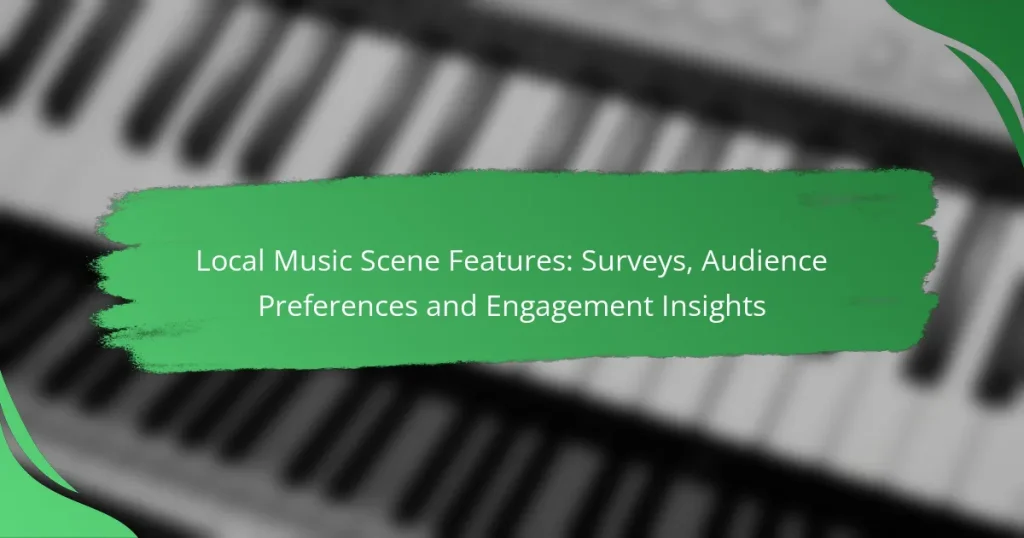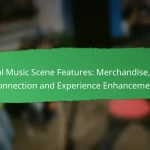The local music scene thrives on community engagement and understanding audience preferences. By utilizing surveys and interactive strategies, venues can create immersive experiences that resonate with diverse audiences. Tailoring events to meet the interests of music lovers not only fosters connections but also enhances attendance and participation.
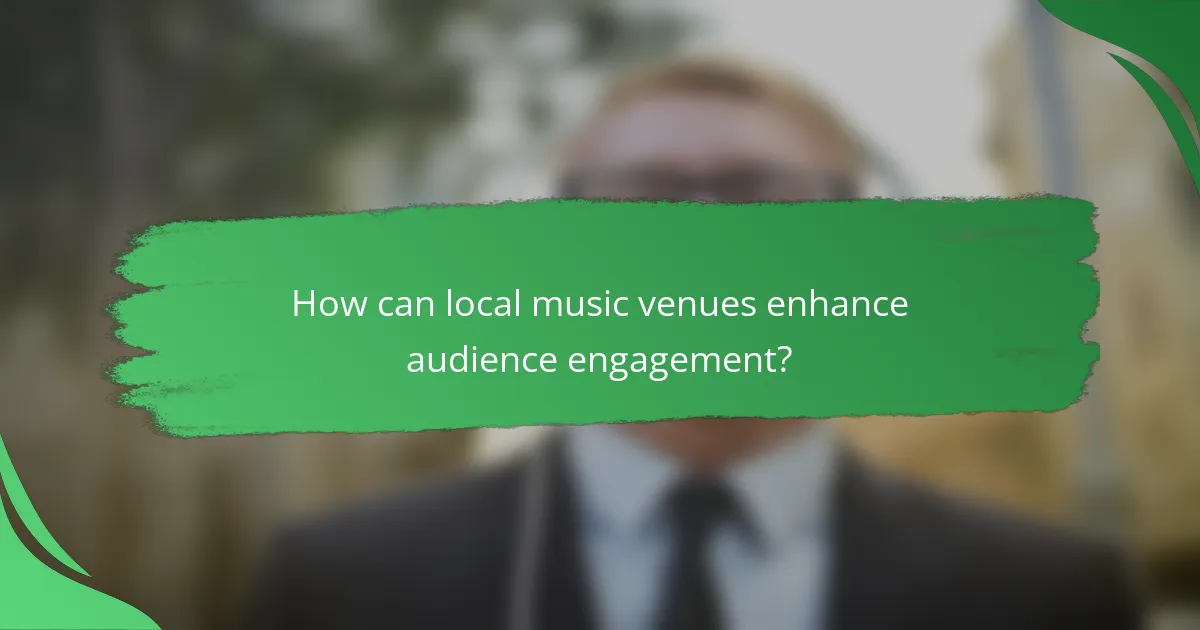
How can local music venues enhance audience engagement?
Local music venues can enhance audience engagement by creating immersive experiences that foster community connections and encourage participation. By implementing interactive strategies, venues can attract diverse audiences and build lasting relationships with music lovers.
Interactive events and workshops
Hosting interactive events and workshops allows audiences to engage directly with music and artists. These can include instrument lessons, songwriting sessions, or even open mic nights where attendees can showcase their talents. Such activities not only entertain but also create a sense of belonging within the local music community.
Consider scheduling these events regularly to maintain interest. Collaborating with local musicians as instructors can also enhance the appeal and authenticity of the workshops.
Social media campaigns
Effective social media campaigns can significantly boost audience engagement by promoting events and creating buzz around local artists. Venues should utilize platforms like Instagram, Facebook, and TikTok to share behind-the-scenes content, artist interviews, and live updates during performances.
Engagement can be further increased by encouraging user-generated content, such as fans sharing their experiences at the venue. Offering incentives like ticket giveaways or exclusive access can also motivate audiences to participate online.
Collaborations with local artists
Collaborating with local artists can enhance the venue’s reputation and draw in their fan base. This can take the form of co-hosted events, featuring local acts as opening performers, or even creating themed nights that celebrate specific genres or cultures.
Such partnerships not only support local talent but also enrich the venue’s programming, making it more appealing to a wider audience. Establishing long-term relationships with artists can lead to recurring events that keep patrons coming back.
Exclusive merchandise offers
Offering exclusive merchandise can create a unique experience for attendees and serve as a tangible reminder of their visit. Items like limited-edition t-shirts, vinyl records, or signed memorabilia can appeal to fans and encourage them to support the venue and artists.
Consider bundling merchandise with tickets for special events or offering discounts for loyal customers. This strategy not only boosts sales but also fosters a sense of community among patrons.
Live streaming performances
Live streaming performances can expand the reach of local music venues beyond their physical location. By broadcasting shows online, venues can attract viewers who may not be able to attend in person, increasing overall engagement and potential revenue.
To maximize the impact, ensure high-quality audio and video production. Promote the live streams through social media and consider offering exclusive content or Q&A sessions with artists to enhance viewer interaction.
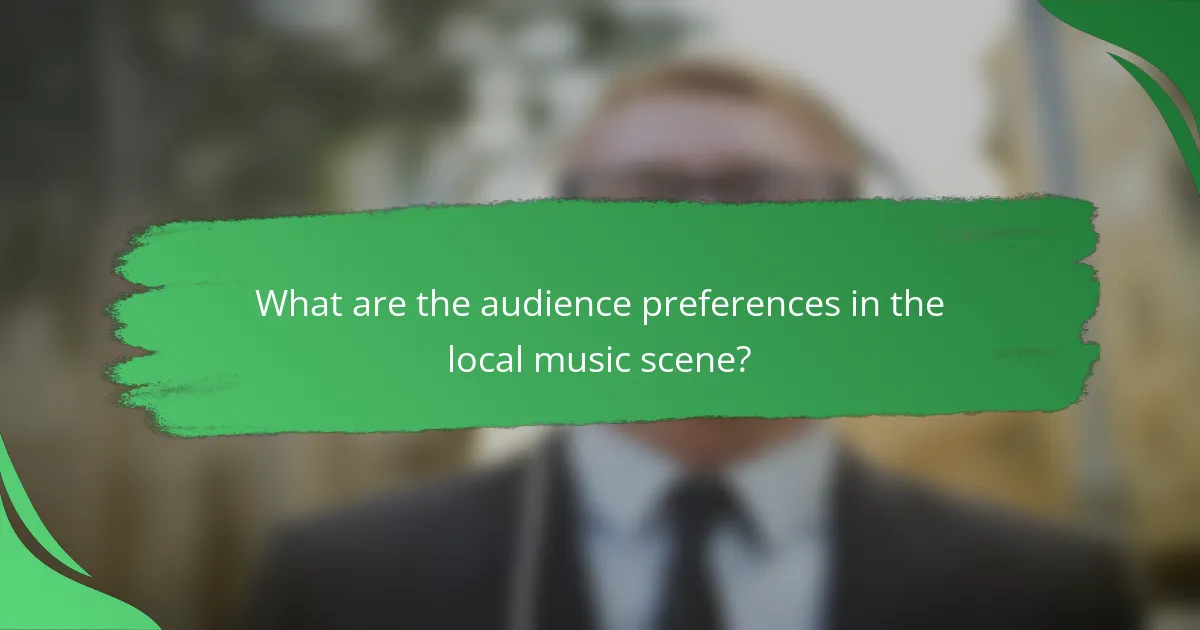
What are the audience preferences in the local music scene?
Audience preferences in the local music scene vary widely, influenced by factors such as genre, performance format, and demographic characteristics. Understanding these preferences helps artists and venues tailor their offerings to better engage with their audiences.
Genre popularity trends
Genre popularity trends reveal which music styles resonate most with local audiences. Commonly favored genres often include pop, rock, and electronic music, while niche genres like indie or jazz may have dedicated but smaller followings. Tracking these trends can help artists and promoters make informed decisions about setlists and marketing strategies.
Local surveys often indicate that audiences appreciate a mix of familiar hits and emerging artists, suggesting a balanced approach can attract a broader crowd. Additionally, seasonal events or festivals may highlight specific genres, impacting their popularity temporarily.
Preferred performance formats
Preferred performance formats can significantly affect audience turnout and engagement. Many attendees enjoy live concerts in intimate venues, while others may prefer larger festivals or outdoor events. The choice of format often depends on the genre being performed and the overall experience desired by the audience.
Interactive formats, such as open mic nights or jam sessions, tend to foster community involvement and can attract diverse crowds. Venues should consider offering a variety of formats to cater to different audience preferences and enhance overall engagement.
Demographic insights
Demographic insights provide valuable information about the audience composition in the local music scene. Factors such as age, gender, and cultural background can influence music preferences and attendance patterns. For instance, younger audiences may gravitate towards contemporary genres, while older demographics might favor classic rock or folk music.
Understanding these demographics allows artists and venues to tailor their marketing efforts effectively. For example, social media campaigns targeting younger audiences can be more effective when promoting pop or electronic events, while traditional advertising methods may work better for older crowds attending classic music performances.
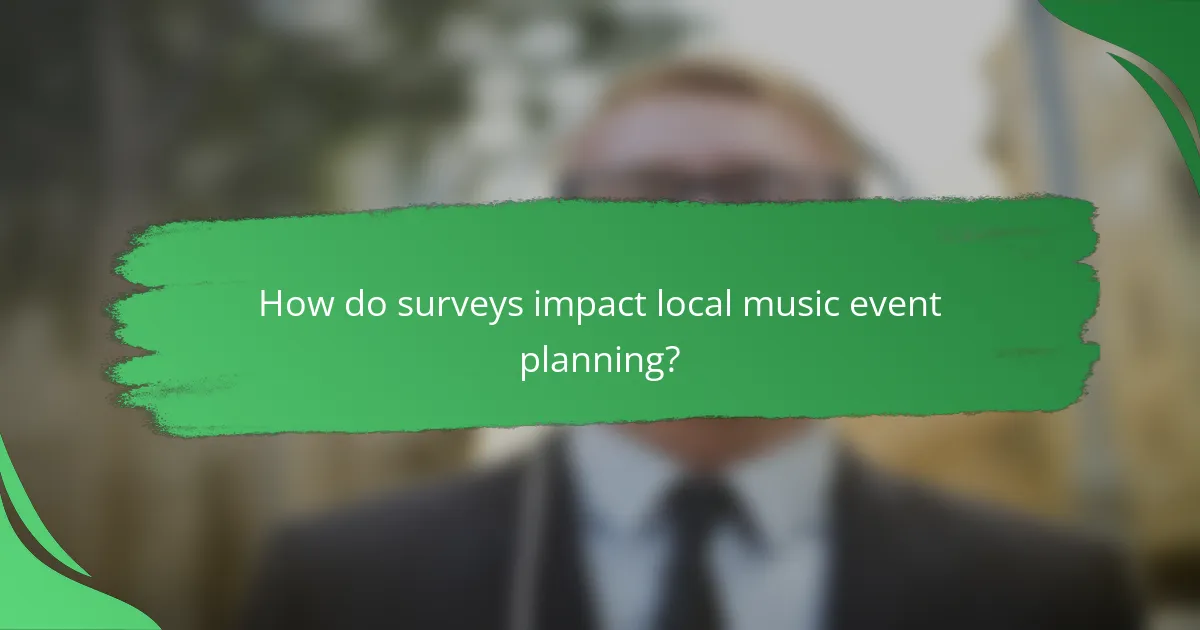
How do surveys impact local music event planning?
Surveys play a crucial role in local music event planning by gathering audience preferences and insights, which help organizers tailor their events to meet community interests. By understanding what attendees want, planners can enhance the overall experience and increase attendance.
Feedback for artist selection
Surveys provide valuable feedback on which artists or genres resonate most with the local audience. This information allows event planners to select performers that align with community tastes, increasing the likelihood of ticket sales and engagement.
For example, if a survey indicates a strong preference for indie rock over pop, organizers can prioritize booking indie bands. This targeted approach can lead to higher attendance and a more satisfied audience.
Data-driven marketing strategies
Utilizing survey data enables planners to develop effective marketing strategies tailored to their audience. By analyzing responses, organizers can identify the best channels for promotion, such as social media platforms or local radio stations.
For instance, if surveys reveal that a significant portion of the audience prefers Facebook for event updates, planners can focus their advertising efforts there. This targeted marketing can improve outreach and boost ticket sales.
Audience satisfaction metrics
Surveys help measure audience satisfaction by collecting feedback on various aspects of the event, such as venue choice, artist performance, and overall experience. This data is essential for understanding what worked well and what needs improvement.
After an event, organizers can analyze satisfaction scores to make informed decisions for future planning. For example, if attendees rate the sound quality poorly, planners can prioritize better audio equipment for upcoming events, ensuring a more enjoyable experience for the audience.

What are the best practices for conducting audience surveys?
Effective audience surveys are crucial for understanding preferences and enhancing engagement within the local music scene. Best practices include utilizing technology for ease of access, incentivizing responses to boost participation, and analyzing the data systematically for actionable insights.
Utilizing online survey tools
Online survey tools like SurveyMonkey, Google Forms, and Typeform streamline the process of gathering audience feedback. These platforms allow for customizable questionnaires that can be easily distributed via social media or email, reaching a wider audience efficiently.
When selecting a tool, consider factors such as user-friendliness, data export options, and integration capabilities with other software. Aim for surveys that are mobile-friendly, as many users will access them via smartphones.
Incentivizing participation
Offering incentives can significantly increase survey participation rates. Common incentives include entry into a raffle for concert tickets, merchandise discounts, or exclusive content access. These rewards not only motivate respondents but also enhance their connection to the local music community.
Keep incentives relevant to your audience’s interests. For example, if your audience is primarily young adults, consider offering free drinks or merchandise from local artists. Ensure that the value of the incentive aligns with the effort required to complete the survey.
Analyzing survey data effectively
After collecting survey responses, effective analysis is key to deriving meaningful insights. Start by categorizing data into themes, such as genre preferences or event attendance, which can help identify trends within your audience.
Utilize visual tools like charts and graphs to present findings clearly. Look for patterns that indicate strong preferences or areas needing improvement. Regularly review and update your analysis to adapt to changing audience dynamics and preferences.

How can local music festivals adapt to changing audience needs?
Local music festivals can adapt to changing audience needs by actively engaging with their attendees and incorporating feedback into their planning processes. This involves understanding preferences for music genres, accessibility, and overall festival experience to create an inclusive environment that resonates with diverse audiences.
Incorporating diverse genres
To attract a wider audience, local music festivals should incorporate a variety of music genres beyond the traditional offerings. This can include genres like hip-hop, electronic, folk, and world music, appealing to different age groups and cultural backgrounds.
Festivals can conduct surveys prior to the event to gauge audience preferences, ensuring that the lineup reflects the interests of the community. Additionally, featuring local artists alongside well-known acts can enhance engagement and foster a sense of local pride.
Enhancing accessibility features
Improving accessibility features is crucial for making local music festivals welcoming to all attendees. This includes providing wheelchair access, designated seating areas, and sensory-friendly spaces for individuals with sensory sensitivities.
Festivals should also consider offering materials in multiple languages and ensuring that staff are trained to assist attendees with disabilities. By prioritizing these features, festivals can create a more inclusive atmosphere that encourages participation from a broader audience.
